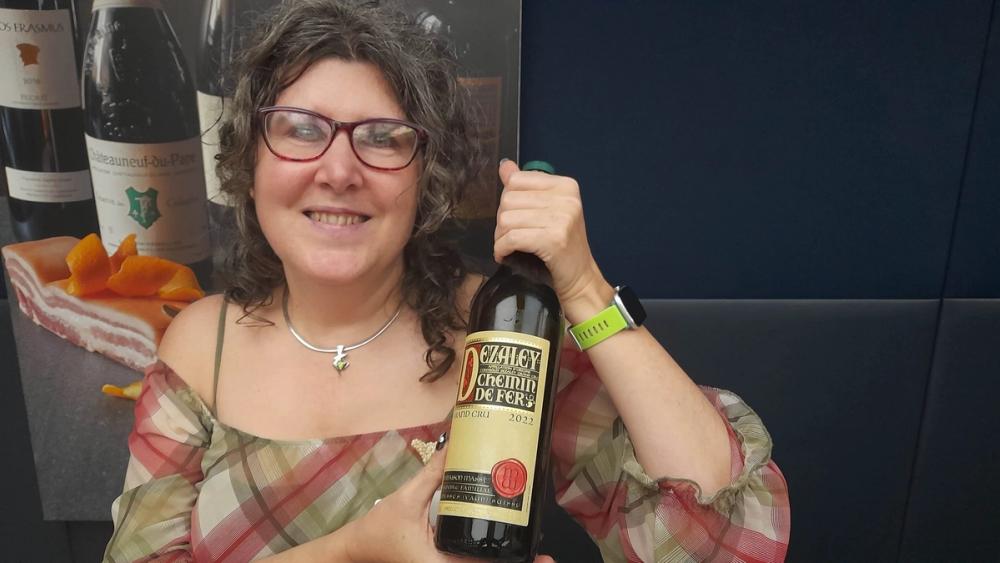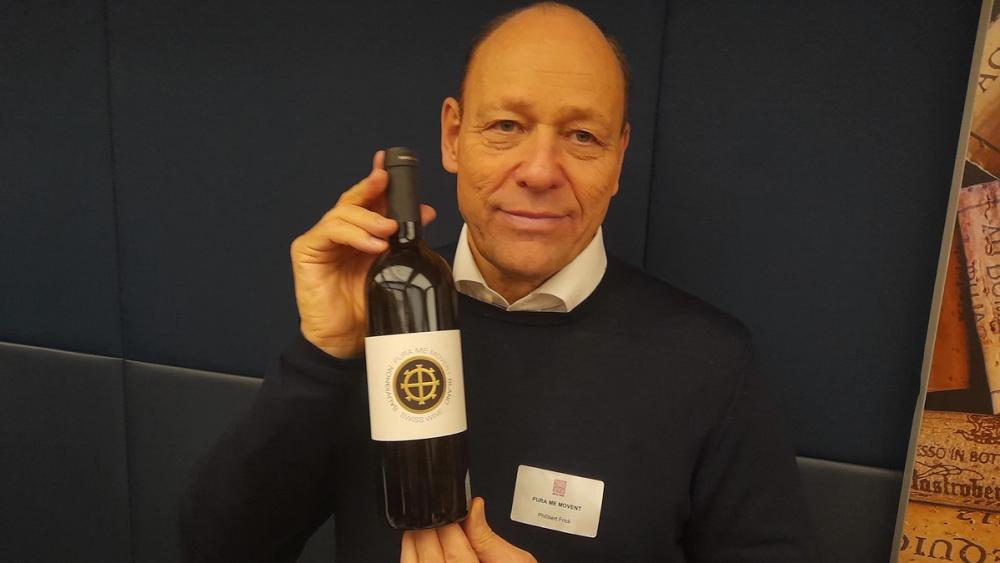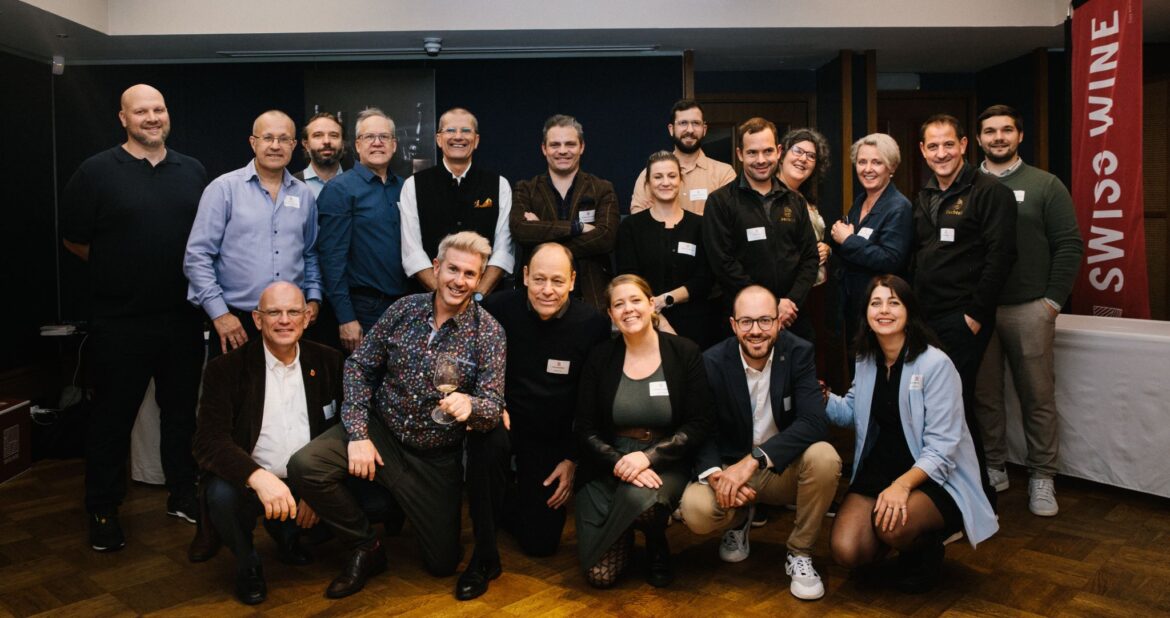Swiss Wine Promotion (SWP), the national promotion body for Swiss wines, launched an autumnal charm offensive in London in the first half of November. This second edition of Swiss Wine Week (the first having been 12 months earlier) featured a series of events that began with an evening drinks party at the Swiss embassy – with Swiss wines only of course – and culminated in twin tasting sessions by 15 Swiss producers and two importers at 67 Pall Mall for the trade and public alike.
Although only one per cent of Swiss wine is exported, SWP’s mission is twofold: to increase that, and to enhance the image of Swiss wines abroad as tasked by the IVVS (Interprofession de la Vigne et des Vins Suisses).
“The UK is a good market for us as we have many partners to help export more here,” says Okséane Gex, deputy director of SWP. “The image of Swiss wines is important, and I think Swiss Wine Week shows we have very good potential here. We have noticed that the specialities of Switzerland like Chasselas, Humagne Rouge and Petite Arvine are working well. People are very curious to discover them. We know we can never be competitive for supermarkets, but for private clients, B2B clients and restaurants we can answer the requests they have.”

Swiss Wine Promotions’ Okseane Gex (l) & Jasmin Schmid
Exports goal
While Germany is Switzerland’s number one export market for its wines, the UK is in the top five and has actually increased imports of Swiss labels in the last two years.
“Our sales have doubled in that time,” revealed Joelle Nebbe-Mornod, owner of Alpine Wines, the online UK wine retailer. Other UK importers of Swiss wines include Keeling Andrew and Buckingham Schenk. A dozen London restaurants stock Swiss wines, while 70 retail outlets in the UK sell them. 67 Pall Mall has over 100 listings of Swiss wines.
Jasmin Schmid, export project manager for SWP, revealed that “our goal for the next couple of years is to raise exports to 2% of production for all foreign markets. We’re looking at the premium segment mainly. We want to create more awareness of our wonderful Swiss wines and increase wine tourism.”
Just published this year, and an ideal book for the wine tourist, is Switzerland: The Smart Traveller’s Wine Guide, co-written by the organiser of Swiss Wine Week, Simon Hardy, and Swiss resident Marc Checkley.
Reds now dominate
The diversity of Swiss wines is such that they have over 250 varieties, as well as 62 different AOCs. Major categories of soil number as many as 15. “But these categories can be endlessly multiplied, with two vines planted only ten metres apart potentially growing in completely different soil types,” writes Thomas Mumenthaler in his reference work on the geology of Swiss wines, Roche et Vin.
Whereas Switzerland used to be renowned for its white wines, three red varieties now dominate, with Pinot Noir, Merlot and Gamay making up over 40% of the 14,484 hectares under vine. Remarkably, nearly 40% of Swiss vineyards are planted to 24 native varieties, which include Chasselas, Petite Arvine, Amigne, Räuschling, Humagne Rouge, Completer, and Rèze. Chasselas, with 26% of all plantings in Switzerland, is second only to Pinot Noir and very much the country’s signature white grape.

Alpine Wines’ Joelle Nebbe-Mornod
Tasting new Swiss wines
Indeed, in the canton of Vaud, Switzerland’s second biggest wine region after Valais, Chasselas makes up 60% of all plantings. Known as Fendant in Valais, Perlan in the Geneva region and Edelweiss or Gutedel in the German-speaking region, it expresses its terroir especially well. Domaine Histoire d’Enfer, the Valais producer looking for a UK importer, had a wide range at the tasting that included its Fendant ‘L’Enfer du Calcaire’ 2023. Whereas that had pleasingly bitter notes, the Vaud winery, Massy Vins’ Dézaley Grand Cru Chemin de Fer 2022 Chasselas (imported by Alpine Wines) exhibited minerality and impressive depth.

Pura Me Movent’s Philibert Frick
Fellow Vaud producer, Pura Me Movent (which owner Philibert Frick said translates as ‘What is pure pushes me forward’), opened a Chasselas from 2015 (‘Parcel Sélection Rosset’, AOC La Côte) which showed how well it can age. Château Maison Blanche’s Grand Cru Yvorne 2023 likewise underlined the high quality of Vaud’s Chablais AOC Chasselas.
Valais winery, Cave des Amandiers, showed three different labels of Petite Arvine, the white grape that is so popular in that region. Blessed by both zippy acidity and salinity, the trio exhibited notes of pink grapefruit, pineapple and citrus. Domaine du Mont d’Or, whose UK importer is Buckingham Schenk, unfurled its Aphrodite Petite Arvine du Valais 2024, which had fabulous intensity of flavour. The Sylvaner Siccus Johannisberg 2024 also showed well.
Only 60 hectares of the white varietal Räuschling are found in Switzerland. Bechtel Weine, from the German-speaking wine region, brought along its Räuschling Sélection 2024 Zürich AOC. Shrill acidity and fresh citrus notes were its chief characteristics. Its Chardonnay Sélection 2024, which is imported by Alpine Wines, showed lovely freshness along with structure from 30% new oak (500-litre barriques).

Bechtel Weine’s Matthias Bechtel
Likewise, Bechtel Weine’s flagship Bechtus Pinot Noir 2022 comfortably absorbed 100% new oak. Low-yielding vines on very steep Zürich AOC terraces at 350-390 metres near the river Rhine produced some complex fruit for this label. From the same village as Bechtel (Eglisau), Weingut Pircher, which is looking for UK distribution, produced an excellent Pinot Noir Sélection Stadtberg 2022 as well as a rich Pinot Gris 2024 and a particularly fresh Riesling 2023 (with a pH at bottling of 3.0).
Not far from Eglisau, Julien Hauser, winemaker at Gasthaus & Weingut Bad Osterfingen, crafts some fine Schaffhausen AOC Pinot Noir on stoney limestone soils at 450-500m, and is another seeking UK distribution. Well-known for his Pinot Blanc, of which only 100 hectares are grown in Switzerland, he also crafts some good Chardonnay, with the 2024 vintage impressing.

Georg Schlegel
Some of Switzerland’s very best Pinot Noir can be found in the Graubünden appellation. One winery from it, Weingut zur Alten Post, was represented at 67 Pall Mall by winemaker Georg Schlegel, who was another seeking UK distribution. His outstanding Pinot Noir Novant 2020, from a very low-yielding single vineyard near Jenins, was matured in 50% new oak and spent three years in bottle before release.
The Ticino region is likewise renowned for the quality of its Merlot. Gialdi Vini sales manager Ettore Muller was on hand to show a pair of its top Merlots, Sassi Grassi 2022 and Riflessi d’Epoca 2022. Imported by Alpine Wines, these were superb examples with intensity and well-integrated tannins.
Switzerland’s native red grape, Humagne Rouge, found delightful expression in Domaine Histoire d’Enfer’s Cornalin ‘L’Enfer du Calcaire’ 2020. Dark in colour with rustic but well-integrated tannins, it had smoky aromas with peppery notes and attractive black fruit. More refined tannins were evident in fellow Valais AOC producer, Cave des Amandiers’ Syrah Les Tatzes 2022, where that varietal flourishes.
Finally, a sweet wine from a grape indigenous to Valais that was first mentioned as long ago as 1686 as growing between Sion and Sierre. Amigne is now almost exclusively found in the nearby village of Vétroz. Domaine Jean-René Germanier is one of its best producers of this luscious dessert wine, MITIS Amigne de Vétroz 2023, which has 130 g/l of residual sugar and is 14.5% abv. Orange zest, tangerine and honey notes are apparent. Semi-sweet and dry versions are also made, with the number of bees on the label indicating sweetness – one for dry, two for semi-sweet and three for sweet.
Lead image ©Tom Bradley


Dining and Cooking